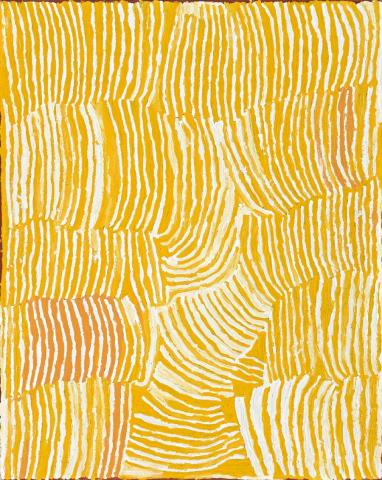LUPULNGA ROCKSITE, 2004
MAKINTI NAPANANGKA
synthetic polymer paint on linen
153.0 x 122.0 cm
inscribed verso: artist’s name, size and Papunya Tula Artists cat. MN0401166
Papunya Tula Artists, Alice Springs
Framed Gallery, Darwin
Private collection, Queensland
Makinti Napanangka was always referred to as 'number one' by the women artists of Kintore. She was born in the early 20th century around Lake Macdonald and thus the Lupulnga Rocksite dreaming became one of her principal stories to paint. Napanangka began painting with acrylic on canvas in 1994 for the Kintore-Haasts Bluff collaborative canvas project. In 1996 she commenced painting for Papunya Tula, though tragically by 1999 Napanangka was almost blind with cataracts and was reliant on her daughters to lead her on her daily ritual to paint. Her sight was restored after successful surgery and a visual revolution occurred in her art.
Much has been written about the resulting 'light-flooded' canvases of Napanangka's first solo show in Sydney in 2000. Her prominence as a Pintupi woman painter became increasingly apparent when her masterpiece Untitled, 2000, was selected for the Art Gallery of New South Wales survey exhibition Papunya Tula: Genesis and Genius. Then in 2002 the National Gallery of Victoria purchased Women's Dreaming at Lupulng, a large scale work that shares many similarities with Lupulnga Rocksite in its inspiration and execution. Napanangka's talents continued to be held in high regard and in 2008 when she was awarded the prestigious National Aboriginal and Torres Strait Island Art Award.
This work depicts one of Makinti Napanangka's most sacred stories known as the hair string ceremony, in which she often participated as a lead dancer. It is accompanied by a certificate from Papunya Tula Artists which states, 'This painting depicts designs associated with the rockhole site of Lupulnga, south of the Kintore Community. The Peewee (small bird) Dreaming is associated with this site. A group of women visited the site before continuing their travels north to Kintore. The lines in the painting represent the spun hair-string which is used in the making of hairbelts worn during ceremonies associated with the area.'
Lara Nicholls
